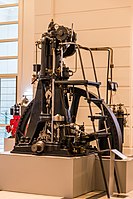
Photo from wikipedia
Abstract This study deals with the experimental research on combustion process, gaseous emissions characteristics and particle size distributions of a high pressure common-rail direct injection (CRDI) diesel engine operating with… Click to show full abstract
Abstract This study deals with the experimental research on combustion process, gaseous emissions characteristics and particle size distributions of a high pressure common-rail direct injection (CRDI) diesel engine operating with PODE/diesel blends at different injection pressures (80 MPa, 90 MPa and 100 MPa) and injection timings (0.5°CA ATDC, 2.5°CA ATDC and 4.5°CA ATDC). The testing fuels were neat diesel, PODE/diesel blends with PODE volume fractions of 10% and 20%, which were marked as P0, P10 and P20 respectively. The results show that the maximum combustion pressure and peak value of heat release rate increase with the increment of injection pressure while the combustion pressure decreases slightly with the delay of injection timing. The CO, HC and soot emissions of the blended fuels decrease obviously with the increase of injection pressure, while the NOx increases, in which the increasing extent of NOx by fueling P10 is smaller than those of P0 and P20 fuels. Even though CO, HC and soot of the three fuels increase with the delay of injection timing, the NOx emissions decrease and the gaseous emissions of P10 fuel are still less affected by injection timing. The peak values of particle number concentration curves of the blends decrease with higher injection pressure, among which the proportion of accumulation particles decreases and the proportion of nucleation particles increases. The particle number concentration increases with the delay of injection timing for each testing fuel, but the geometric mean diameter (GMD) of P10 particles is little affected by the injection timing. Also, the particle diameter corresponding to the peak concentration for each testing fuel decreases with the increase of injection pressure and the advance of injection timing.
Journal Title: Fuel
Year Published: 2020
Link to full text (if available)
Share on Social Media: Sign Up to like & get
recommendations!